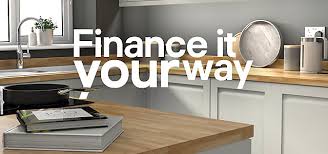Kitchen cabinets are more than just storage spaces; they’re the backbone of your kitchen’s aesthetics and functionality. However, the cost of quality cabinets can often be a significant hurdle for homeowners looking to upgrade or renovate their kitchens. This comprehensive guide will explore various options for financing kitchen cabinets, helping you transform your kitchen without breaking the bank.
Understanding the Cost of Kitchen Cabinets
Before diving into financing options, it’s crucial to understand what you’re paying for. Kitchen cabinet costs can vary widely based on several factors:
Factors Affecting Cabinet Costs
- Cabinet Type:
- Stock cabinets: $60-$200 per linear foot
- Semi-custom cabinets: $100-$650 per linear foot
- Custom cabinets: $500-$1,200+ per linear foot
- Materials:
- Laminate: $50-$75 per linear foot
- Wood veneer: $80-$150 per linear foot
- Solid wood: $150-$500+ per linear foot
- Size of the Kitchen:
- Small kitchen (10×10): $2,000-$24,000
- Medium kitchen (12×12): $2,400-$29,000
- Large kitchen (14×16): $3,200-$38,000+
- Additional Features:
- Soft-close hinges
- Pull-out organizers
- Built-in lighting
- Custom finishes
- Installation Costs:
- Professional installation: $50-$250 per cabinet
- DIY installation: Cost of tools and materials
Understanding these costs will help you set a realistic budget and determine how much financing you may need.
Assessing Your Financial Situation
Before exploring financing options, it’s essential to evaluate your current financial standing. This assessment will help you determine which financing methods are most suitable for your situation.
Steps to Assess Your Finances
- Check Your Credit Score:
- Obtain your free credit report from AnnualCreditReport.com
- Review for errors and dispute any inaccuracies
- Understand how your score impacts loan options and interest rates
- Calculate Your Debt-to-Income Ratio (DTI):
- Add up all monthly debt payments
- Divide by your gross monthly income
- Multiply by 100 to get your DTI percentage
- Aim for a DTI below 43% for better loan options
- Evaluate Your Savings:
- Determine how much you can contribute as a down payment
- Consider setting aside funds for unexpected costs
- Create a Realistic Budget:
- Factor in all costs associated with the cabinet project
- Include a buffer for unforeseen expenses (typically 10-20% of the total budget)
- Determine Your Monthly Payment Comfort Zone:
- Calculate how much you can comfortably afford to pay each month
- Consider potential changes in income or expenses over the loan term
By thoroughly assessing your financial situation, you’ll be better equipped to choose a financing option that aligns with your budget and long-term financial goals.
Financing Options for Kitchen Cabinets
Now that you have a clear understanding of costs and your financial situation, let’s explore various financing options available for kitchen cabinets.
1. Personal Loans
Personal loans are unsecured loans that can be used for a variety of purposes, including home improvements like kitchen cabinet upgrades.
Pros:
- Fixed interest rates and repayment terms
- No collateral required
- Quick approval and funding process
Cons:
- Higher interest rates compared to secured loans
- May have origination fees
- Approval and rates heavily dependent on credit score
How to Apply:
- Shop around with multiple lenders (banks, credit unions, online lenders)
- Compare interest rates, terms, and fees
- Gather necessary documentation (proof of income, bank statements, etc.)
- Submit applications within a short time frame to minimize credit inquiries
- Review and accept the best offer
Case Study: Sarah, a homeowner with good credit, secured a $15,000 personal loan at 8% APR for 5 years to finance her kitchen cabinets. Her monthly payment is $304, allowing her to spread the cost over time while enjoying her new cabinets immediately.
2. Home Equity Loans
A home equity loan allows you to borrow against the equity you’ve built in your home, using your property as collateral.
Pros:
- Lower interest rates compared to personal loans
- Interest may be tax-deductible (consult a tax professional)
- Fixed monthly payments
Cons:
- Risk of foreclosure if you default on payments
- Closing costs and fees
- Longer approval process
How it Works:
- Determine your home’s value and your current mortgage balance
- Calculate your available equity (typically up to 80-85% of your home’s value minus your mortgage balance)
- Apply with a lender, providing necessary documentation
- Undergo a home appraisal
- Close on the loan and receive funds in a lump sum
Example: John and Mary have a home valued at $300,000 with a mortgage balance of $200,000. They could potentially borrow up to $55,000 (85% of $300,000 = $255,000 – $200,000 = $55,000) for their kitchen cabinet project.
3. Home Equity Line of Credit (HELOC)
A HELOC is similar to a home equity loan but functions more like a credit card, allowing you to borrow as needed up to a certain limit.
Pros:
- Flexibility to borrow only what you need
- Interest-only payments during the draw period
- Potential tax deductions on interest
Cons:
- Variable interest rates
- Risk of overspending
- Potential for large payment increases after the draw period
How it Works:
- Apply for a HELOC with a lender
- Receive a credit line based on your home’s equity
- Draw funds as needed during the cabinet project
- Make interest-only payments during the draw period (typically 5-10 years)
- Enter the repayment period, paying both principal and interest
Tip: To make the most of a HELOC, create a detailed budget for your cabinet project and only borrow what you need. Consider making principal payments during the draw period to reduce overall interest costs.
4. Credit Cards
While not ideal for large purchases, credit cards can be an option for smaller cabinet projects or as a supplement to other financing methods.
Pros:
- Convenience and quick access to funds
- Potential rewards or cashback
- Some cards offer 0% introductory APR periods
Cons:
- High interest rates after promotional periods
- Potential impact on credit utilization ratio
- Risk of accumulating high-interest debt
Strategy for Using Credit Cards:
- Look for cards with 0% introductory APR on purchases
- Calculate if you can pay off the balance before the promotional period ends
- Use the card exclusively for the cabinet project to track expenses
- Set up automatic payments to ensure timely repayment
- Consider a balance transfer if needed to extend the low-interest period
Caution: Only use credit cards if you have a solid plan to pay off the balance quickly. The high interest rates can quickly negate any initial savings or rewards.
5. Contractor Financing
Many cabinet retailers and contractors offer financing options, either in-house or through partnerships with lenders.
Pros:
- Convenient one-stop-shop for cabinets and financing
- May offer promotional rates or deferred interest deals
- Often have options for various credit profiles
Cons:
- Potentially higher interest rates than other options
- Limited flexibility in terms and conditions
- Risk of predatory lending practices with some retailers
What to Look For:
- Transparent terms and conditions
- Competitive interest rates
- No prepayment penalties
- Positive reviews and reputation of the contractor or retailer
Quote from Industry Expert: “While contractor financing can be convenient, always compare the terms with other financing options. Don’t let the allure of a ‘one-stop-shop’ cloud your judgment on the overall cost of the loan.” – Jane Smith, Consumer Finance Advisor
6. Government Loans and Assistance Programs
Various government programs offer loans or assistance for home improvements, including kitchen renovations.
Options to Explore:
- FHA 203(k) Rehabilitation Loan:
- Combines home purchase or refinance with renovation costs
- Lower down payment requirements
- Available for both minor and major renovations
- HUD Title I Property Improvement Loan:
- For home improvements that substantially protect or improve the property
- Loans up to $25,000 for single-family homes
- No home equity required
- USDA Rural Development Home Repair Loans and Grants:
- For very low-income homeowners in rural areas
- Loans up to $20,000 with 1% interest rate
- Grants up to $7,500 for elderly homeowners
- State and Local Programs:
- Many states and municipalities offer home improvement loans or grants
- Research options specific to your area
How to Apply:
- Determine eligibility based on income, location, and project scope
- Gather necessary documentation (proof of income, property information, project plans)
- Apply through approved lenders or directly with the government agency
- Follow specific program guidelines for fund usage and reporting
Fact: According to the U.S. Department of Housing and Urban Development, over 17,000 Title I Property Improvement Loans were issued in 2020, helping homeowners finance various home improvement projects, including kitchen upgrades.
Strategies for Maximizing Your Cabinet Budget
Regardless of which financing option you choose, implementing smart strategies can help you get the most value for your money when purchasing kitchen cabinets.
1. Timing Your Purchase
Take advantage of seasonal sales and promotions to maximize your budget.
Best Times to Buy:
- January: Post-holiday sales
- May-June: Memorial Day and Father’s Day sales
- September-October: Labor Day and fall home improvement promotions
- November: Black Friday and Cyber Monday deals
Tip: Sign up for newsletters from cabinet retailers to stay informed about upcoming sales and exclusive offers.
2. Mix and Match Cabinet Types
Combine different cabinet types to balance cost and customization.
Strategy:
- Use stock cabinets for standard sizes and layouts
- Incorporate semi-custom or custom cabinets for unique spaces or special features
- Consider open shelving for some areas to reduce costs
Example: Lisa saved 30% on her kitchen cabinet project by using stock cabinets for most of her kitchen and splurging on a custom island centerpiece.
3. Explore Alternative Materials
Consider alternative materials that offer durability and style at a lower cost.
Options to Consider:
- Thermofoil: Durable, easy to clean, and available in various finishes
- Laminate: Affordable and available in designs that mimic wood or stone
- MDF (Medium-Density Fiberboard): Stable and paintable for a custom look
Fact: According to a 2022 industry report, laminate cabinets account for approximately 30% of the kitchen cabinet market, offering a cost-effective alternative to solid wood.
4. DIY Where Possible
Taking on some aspects of the cabinet installation yourself can significantly reduce costs.
Tasks to Consider:
- Removing old cabinets
- Painting or refinishing existing cabinet boxes
- Installing hardware
- Adding organizational features
Caution: Be realistic about your skills and the time required. Improper installation can lead to costly repairs or replacements.
5. Negotiate with Suppliers and Contractors
Don’t be afraid to negotiate prices, especially for large projects.
Negotiation Tips:
- Get multiple quotes from different suppliers and contractors
- Ask about price matching or beating competitors’ offers
- Inquire about discounts for paying in cash or completing the project during off-peak seasons
- Bundle cabinet purchase with other kitchen renovation elements for potential package discounts
Case Study: The Johnson family saved 15% on their kitchen cabinet project by negotiating with three different suppliers and ultimately choosing the one willing to price match and offer a bulk discount.
Managing Your Cabinet Financing
Once you’ve secured financing for your kitchen cabinets, it’s crucial to manage the loan or credit line effectively to maintain your financial health.
Creating a Repayment Plan
Develop a solid strategy for repaying your cabinet financing to avoid financial stress and potential credit damage.
Steps to Create a Repayment Plan:
- Review your loan terms, including interest rate, monthly payment, and loan duration
- Incorporate the monthly payment into your household budget
- Set up automatic payments to ensure timely repayment
- Consider making extra payments when possible to reduce interest and pay off the loan faster
- Create a contingency plan for handling payments in case of unexpected financial challenges
Tip: Use online loan calculators to see how extra payments can impact your loan term and total interest paid.
Monitoring Your Credit
Keep a close eye on your credit report and score throughout the financing process and repayment period.
Why It’s Important:
- Detect any errors or fraudulent activity quickly
- Understand how the new account impacts your overall credit profile
- Identify opportunities for improving your credit score
How to Monitor Your Credit:
- Use free credit monitoring services offered by many credit card companies
- Check your credit reports annually at AnnualCreditReport.com
- Consider a paid credit monitoring service for more frequent updates and alerts
Fact: According to a Federal Trade Commission study, 1 in 5 consumers had an error on at least one of their credit reports that was corrected after disputing it.
Avoiding Common Financing Pitfalls
Be aware of potential pitfalls that can derail your cabinet financing and overall financial health.
Common Pitfalls to Avoid:
- Overextending Your Budget:
- Stick to your predetermined budget, even if tempted by upgrades
- Include a buffer for unexpected costs
- Ignoring the Fine Print:
- Carefully read all loan documents before signing
- Pay attention to interest rates, fees, and prepayment penalties
- Neglecting Other Financial Goals:
- Balance cabinet financing with other financial priorities (e.g., retirement savings, emergency fund)
- Avoid diverting funds from essential expenses to pay for cabinets
- Failing to Plan for the Entire Project:
- Consider all aspects of the kitchen renovation, not just cabinets
- Ensure your financing covers the entire scope of the project
Quote from Financial Advisor: “Remember, kitchen cabinets are just one part of your overall financial picture. It’s crucial to balance the desire for home improvements with long-term financial stability and goals.” – Michael Johnson, Certified Financial Planner
Bringing Your Dream Kitchen to Life
Financing kitchen cabinets doesn’t have to be a daunting task. By understanding your options, assessing your financial situation, and implementing smart strategies, you can transform your kitchen without compromising your financial health.
Key Takeaways:
- Thoroughly assess costs and your financial situation before seeking financing
- Explore various financing options, from personal loans to government programs
- Implement budget-maximizing strategies to get the most value for your money
- Manage your financing responsibly to maintain financial health
- Stay focused on your overall financial goals while improving your home
Remember, the perfect kitchen cabinets are not just about aesthetics; they’re an investment in your home and quality of life. With careful planning and the right financing approach, you can create the kitchen of your dreams while staying within your financial comfort zone.
Whether you’re opting for a sleek modern look or a cozy traditional style, your new kitchen cabinets are within reach. Take the time to explore your options, crunch the numbers, and make an informed decision. Your future self, enjoying morning coffee in your beautifully renovated kitchen, will thank you for the effort you put into financing your cabinet project wisely.



